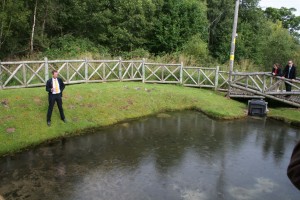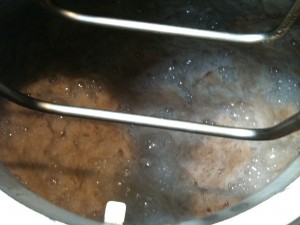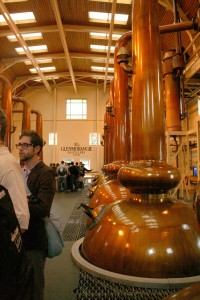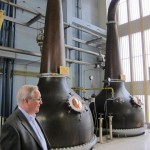Two unique factors that impact the flavor profile of Glenmorangie single malt whisky
30 Aug
Just over two weeks ago, I was lucky enough to visit Scotland and the Glenmorangie distillery with the AMCA class. I learned a great deal on the trip, more than is possible to recount in one blog post. However, I would like to share some aspects of the Glenmorangie whisky production process that I found very interesting. From previous study, I already knew there are a great number of factors that can affect the final expression of a distilled spirit. On this trip, I was able to better understand how circumstance affected two of these factors for Glenmorangie and helped shape the delicious single malt whisky produced by “The Sixteen Men of Tain”.
The first unique factor for Glenmorangie is the water supply. Most water sources in Scotland are low in dissolved mineral content. Near Tain and the Glenmorangie distillery the rain water filters down through the local limestone. According to hydrologists, 100 years later that pure, mineral-rich water resurfaces in Tarlogie Spring. Originally, Tarlogie Spring was the water source for a farm and brewery owned by the distillery founder William Matheson. Since the beginning every drop of Glenmorangie whisky has been produced using water from the spring. Glenmorangie now owns the surrounding 650 acres to protect its water source from any development and uses 250,000L of water direct from the spring each day.
According to master distiller Dr. Bill Lumsden, the high levels of calcium and magnesium salts in the water increase the health and vitality of the yeast during fermentation. This is essential for the very vigorous fermentation that takes place at Glenmorangie. The result is a wash very high in acetate esters and fruity compounds that will carry through the distillation process into the final whisky.
The second of these factors unique to Glenmorangie is the size of its stills. When farmer/brewer William Matheson set up the distillery in the 1840’s, he purchased two used copper pot stills on sale in London. He soon found out they had previously been used for the distillation of gin, not whisky. With too much money invested and unable to return the stills, he had inadvertently become the owner of the tallest stills in Scotland.
Having been lucky enough to have also visited the Beefeater gin distillery in London just days prior, I had a sense of déjà vu when I first saw the now 12 pot stills in operation at Glenmorangie. They remain the tallest stills in Scotland.
According to Glenmorangie manager Andy MacDonald, the extra length of the still neck has two benefits. First, the vapors of the distillate must travel further to escape the still, ensuring only lighter, pure spirits reach the condenser. Second, longer contact with the copper neck ensures the removal of more sulfides during distillation. These stills,unique in whisky distillation and combined with a unique water source, are key contributors to the fruity and floral flavor profile that Glenmorangie is known for producing.
The very important maturation process of Glenmorangie whisky has not even been mentioned. This process is obviously key to many of the differences found not only with other whisky brands, but also between the different expressions of Glenmorangie. However, while we did learn much about that process, it is beyond the scope of this particular post.
Thanks to Glenmorangie and Moët Hennessy, especially Dr. Bill Lumsden, Andy MacDonald, Steve Shure, and Rachel Moorhead for making this tremendous learning experience possible. Also, thank you to all my fellow AMCA classmates, who help inspire me to learn more every day. Special thanks to Beefeater and their brand ambassador Dan Warner, as well as Simon Ford of Pernod Ricard for setting up the private tour for several of us in London. HUGE thanks to Bridget, whose boundless energy and drive made all this possible. It is impossible to overstate how much she has done to “raise the bar” in Chicago. Finally, thanks to Natalia for saying yes. Made this the best trip ever!





No comments yet